Remarketing in Google Ads consists of static images, animated images, video, responsive ads, and text ads that are placed on the Google Display and Google Search Network. What makes remarketing different from standard Display and Search advertising is the targeting. Remarketing consists of using a special tracking code to place cookies on the browsers of people visiting your website, and then serving ads to those with that cookie, specifically, on the Display and Search network. It can be a very powerful component of a PPC campaign.
The main point with remarketing is that you want to find those people who have shown enough interest in your products or services to visit your website. These people are more likely to perform whatever activity you’re considering a conversion compared to people who have not yet been to your website.
Remarketing strategy can be broken down into the following:
- Type of remarketing – search, display, video, dynamic, etc
- How to segment website visitors into separate audiences
- What to test when remarketing
- How to optimize these remarketing campaigns.
In this guide, we will delve into these topics and give best practices based on experience and Google recommendations.
Google Ads Remarketing Options
- Standard remarketing – This Google Ads feature allows you to show ads to your past visitors as they browse websites and apps on the Display Network.
- Dynamic remarketing – A feature of Google Ads that lets you show ads, to past visitors, of any products or services that they viewed on your site
- Remarketing for mobile apps – If someone used your mobile app or mobile website, Google Ads will let you show ads to them when they use other mobile apps or are on other mobile websites.
- Remarketing lists for search ads – This Google Ads feature is also known as RLSA. It enables you to target past visitors on the Search Network. You can target and customize search ads for these past visitors while they search on Google and Google’s Search partner sites.
- Video Remarketing – Google Ads will allow you to serve ads to people who have interacted with your YouTube channel or other videos. You can serve them ads on YouTube or through Display Network videos and websites.
- Email list remarketing – Also known as Customer Match, if you have a list of emails from your customers, you can upload them to Google Ads. This feature enables you to serve ads to them if they are signed in to Google Search, Gmail, or YouTube.
Selecting Your Audiences
The very first step to remarketing, like most things in paid advertising, is to analyze your data and develop a strategy. You’ll need to decide which site visitors you would like to retarget with ads. These groups, the ones you want to target separately and the ones you don’t want to target at all, are audiences. There is an infinite number of ways to target these audiences, including:
- Based on the product page visited
- Based on visiting a certain page of your checkout process
- Based on not visiting a certain page (like a “confirmation” or “thank-you” page)
- Time on site
- Number of pages visited
- Demographic targeting
- Geographic targeting
There are also custom combinations, which we’ll describe more in detail later, which allow you to target people who visited one page without visiting another. The strategy here would be, for example, to target people who visited the first page of your checkout process without hitting the thank-you page. This would mean targeting users who were interested enough in your product to add an item to their cart, but for whatever reason didn’t complete the process.
You can target any audience based on URLs. If you have a “thank-you” page after people submit their email address for signing up to get more information or register to see a special deal, you could use the URL of that thank you page for a remarketing list.
Here are some possible steps you can use as you’re getting started:
- Think about all the URLs you want to target on your site and make a list in Excel. Name the audience and list the URL for reference later.
- Include all the ideas you come up with for custom combinations of audiences
- If you have Google Analytics goal funnels set up, use the data gathered to analyze and find points in the consumer funnel to remarket
- If you don’t have Google Analytics funnels set up yet, here’s a blog article we wrote about how to do that here.
How To Set-Up Remarketing Codes
If you have a Google Analytics account, you don’t need to update the code, at all! You simply need to change a setting in the Admin section of GA. Go to Admin > Tracking Info > Data Collection. Toggle the Remarketing button.
If you don’t have one, we suggest you get one but we’ll describe how you can still generate a tracking code in Google Ads. The reason you want a remarketing code from Analytics is the cool feature of being able to set up remarketing lists based on goals instead of just pages visited. You could set one up for people who have visited at least 4 pages, spent at least 5 minutes on your site, etc.
Create Remarketing Lists In Analytics
If you’re using Google Analytics to remarket, here’s how to set up that code. Once you’re in your Google Analytics account, click to the “admin” section.
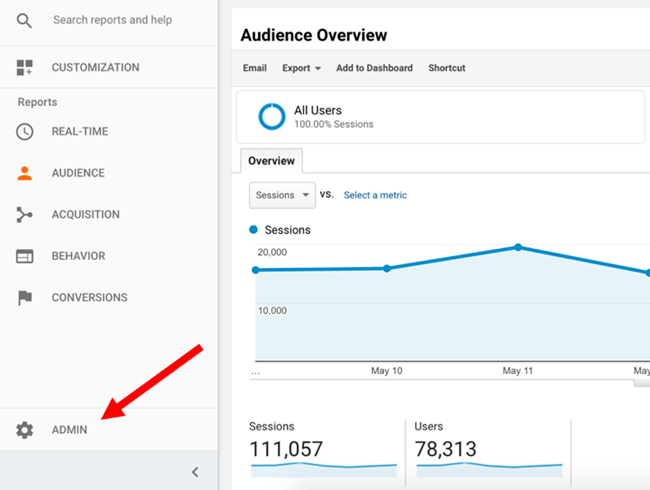
Click the link labeled “audience definitions”. If you don’t see anything that says audience definitions, there is a chance you’re not logged in under a user that’s granted admin access to the Analytics account you’re in. If that’s the case, get access and check back here.
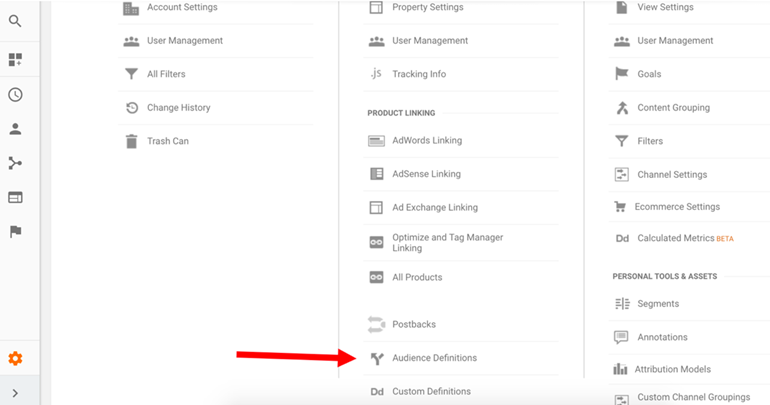
Click the button that reads “audiences”.

Click on the “new audience” button.

These options include naming your list, choosing an Analytics profile and Google Ads account to use with your list, specifying the type of remarketing you want to opt into (all visitors or those that visit certain pages), and the ability to modify the membership duration.
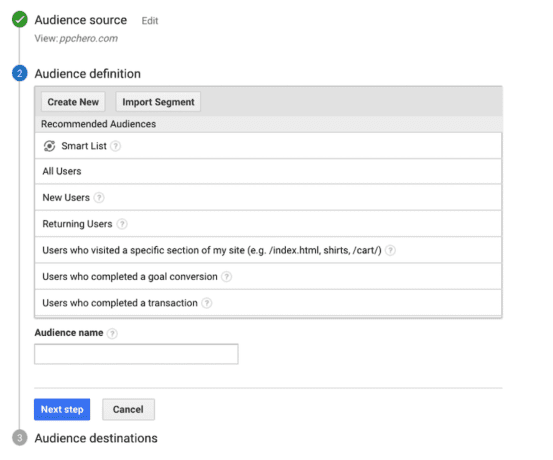
You’ll want to name your list whatever your intention is. We’ll get more into custom combinations later, but you could name it “All site visitors,” “cart abandoners,” etc. We’ll discuss custom membership duration later.
After you’ve made your audiences, you will also need to take care of a few additional items.
- Have at least one active Google Ads or Display & Video 360 account that is linked to your Analytics account (admin access required)
- Agree to the Analytics Terms of Service
- Adhere to the Policy requirements for Analytics Advertising Features.
- Enable Remarketing and Advertising Reporting Features.
- Update your privacy policy and include an appropriate description of your use of remarketing in online advertising.
Now, if you don’t have Analytics, don’t have admin access to it, and/or don’t want to agree to the terms of service, you can still create and manage remarketing lists directly in Google Ads.
Create Remarketing Lists Directly In Google Ads
To do this, you’ll want to go to the “Shared Library” in your Google Ads account. Click “Audience manager”.
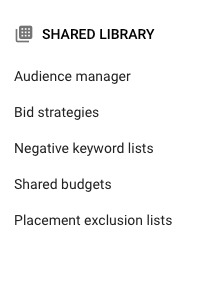
In the Audience lists section, make sure you’re looking at the Remarketing tab.
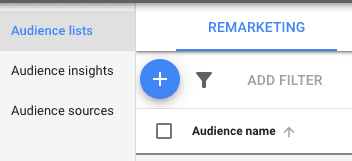
Then, click the “+” button and choose “Website visitors”.
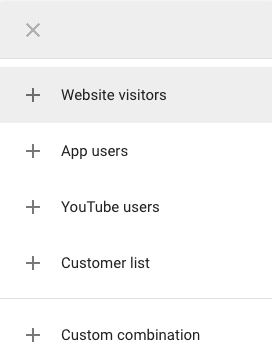
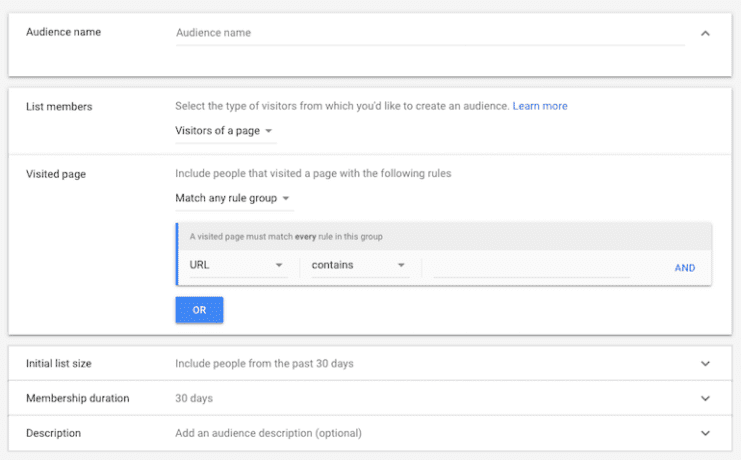
How To Choose Your Membership Duration
The membership duration is how long you’d like to store a cookie in someone’s browser. There are many different strategies for selecting membership duration. You want to think about your business and your goals when selecting membership duration. They can last up to 540 days.
- Do you have an e-commerce site that people only buy from once every three months? You should extend your membership duration to 90 days.
- Do you have a service that requires people to sign up again after 30 days? Try a 60-day membership so you know they’re getting heavily targeted if they forget to renew directly after 30 days.
Another item to keep in mind is that you are always at risk of annoying people if you show them your ad too often.
Frequency Capping
Another feature, in a similar vein to membership duration, is frequency capping. This feature can be found in the Settings of a specific campaign.

This feature allows you to limit how often an individual user can be shown your ad during a specified period. Keep in mind that if you show your ad too often to users, there is a possibility that you will cross the line and they will become annoyed by your product or service. You don’t want this to happen with your ads and your remarketing audiences, so pick a frequency cap that seems appropriate for your goals. If your typical customers have a long time between conversions, you’ll need fewer impressions to gently remind them of your brand again from time to time.
If your business is built for repeat customers, you may want to focus on impressing as much as possible. For instance, restaurants like Jimmy John’s ideally want people to order their sandwiches every single day. They’re not going to care about burning someone out, as it’s feasible that someone could order from them multiple times in a week. Repeat business is important to them, so they show ads to users constantly.
The main point is to pick a frequency cap that makes sense for your business goals.
How To Set-Up Custom Combinations
You can set-up custom combinations in the Shared Library in your Google Ads account, via the Remarketing tab where you set up your Google Ads-based remarketing.
Create a new audience, but this time it will be a Custom Combination.
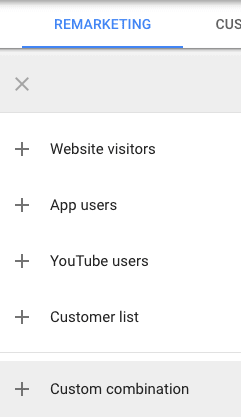
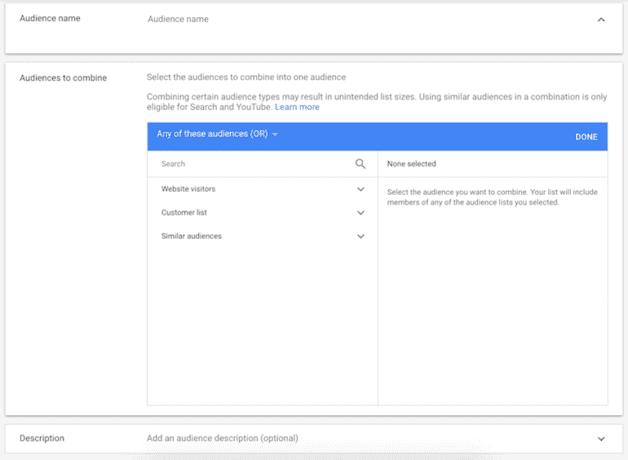
If you want to target users who hit the first page of your checkout process without reaching your order confirmation page, then you would want to set up a custom combination.
Select the remarketing audience you’ve set up for people who hit the first page of your checkout process. You can do this by creating a new remarketing audience and using the URL of that page. Then, select “none of this audience” and select the remarketing audience you set up for people who have hit the thank you page. You can also select anyone who has converted. Save this, and then select this custom combination as your audience in the ad group you’ve created for this audience.
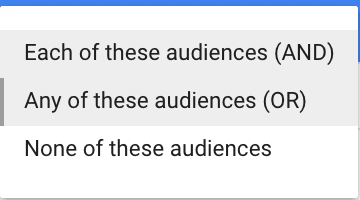
You can also build custom combination audiences with the following audience types:
- Customer lists (Customer Match)
- App users
- Video users
- Similar Audiences
The main takeaway is to think about what could work for your website and test all viable options!
When Custom Combinations And Membership Duration Meet
One strategy that can work well for advertisers is what’s called delayed targeting.
We’ll start with an example. This is a client that is a subscription-based service. Some members elect to pay on a month-to-month basis. So, we decided to make an audience that targets people who have converted with member duration of 30 days. We made another identical audience, but for 90 days. We then made a custom combination by making the 90-day member duration our target and excluded the audience for 30 days. This means we’re targeting people who have converted, 30-90 days after converting.
Membership duration will also intersect with the messaging in your ads. If you have offers that give users a seven-day free trial, you could target converters starting seven days after their initial conversion.
You know your sales cycle better than anyone, so think of creative ways you can make the most of the targeting that remarketing affords you. Users think of your brand 30, 90 or even 180 days after being introduced to it initially. Adjust your messaging accordingly.
How To Optimize Remarketing Campaigns
Optimization in remarketing comes in a few different forms:
- Ad testing
- Strong branding may work well in your ads. Start here as a control, but experiment with other messages. Treat remarketing ads similarly to how you would treat other ads, just keep your audience in mind. These users are already familiar with your brand, so you may need to go a bit further to win them back to your site. Experiment with different offers, calls to action, images and everything else you can think of.
- Custom combination testing
- We mentioned earlier that you may find different results when combining various remarketing categories and similar audiences. Keep testing and find what works best for your account. Experiment with different combinations of cookie lengths. Messaging for visitors that visited between 7 and 30 days ago may very well end up not working for users who visited between 30 and 60 days ago.
- Frequency cap testing
- You don’t want to be too annoying, but you also want to maximize the number of interested visitors that visit your site. Monitor your audience size in combination with the number of impressions your remarketing ad groups get. Maybe your cap is too high and you aren’t limiting anything at all. Maybe you’re setting it way too low and you’re severely limiting your ads’ exposure.
- Bid testing
- Impression share is something worth monitoring in a remarketing campaign. You’re following users and not sites, so if you get to 100% IS you may be annoying some of those users. Monitor your bids both for cost-effectiveness and return on investment, but also for impression share.
- Landing page testing
- The user that you are bringing back to your site already has a certain level of familiarity. You should experiment with sending them to the same page and somewhere completely new. Is your messaging catered to someone who has been there before? Are you asking questions on the landing page that a previous site visitor would already know the answer to? Test to find out which type of content connects most strongly to previous visitors.
While your results may vary, we’ve found the most success with remarketing ads when they are brand focused. This is because the people you’re targeting are familiar with your website. They might not pay any mind to a random creative advertisement, but they may be much more likely to notice an ad that’s touting a brand that they know. This is especially true if you plan on testing special offers for remarketing visitors. They may not notice a discount or sale if they don’t notice that it’s for a site they’ve visited already. Our best advice is to start with ads that match your website and your brand as a control set of ads and test from there.
For the most part, you can probably direct remarketing visitors back to wherever they came from. If they got a remarketing cookie from a product page, it’s probably safe to land them back on that product page. However, if you’re planning on offering specials to them, you’ll want to create a custom landing page that reflects that deal. If they come back to the site and don’t see anything about the deal they were promised in the ad, they’re likely to bounce.
It’s a bit tricky to do placement exclusions for remarketing. If you’re not familiar with what we mean, placement exclusions happen when you download a placement report and decide which sites your ads are performing poorly on that you should block from showing your ads. This is a very easy task when you’re dealing with topics or contextual marketing on the Display Network. Then, you can look at performance and relevancy at face value. However, with audience targeting, such as remarketing or interest category marketing, then you’re targeting the person who happens to be on that website. Content relevancy of the page itself may not be as important in a remarketing campaign as it will be in other Display campaigns.
So, what do you do? You’ll still have websites that perform poorly, and you should still exclude them. Even though we’re targeting people who visited your website, some sites with ad placements attract the wrong people (i.e. people who don’t want to give you money) more than other sites, display your ads in such a way that invite accidental clicks, etc. We recommend being more tolerant with your remarketing placement performance. Give those sites as much tolerance as you can within your goal margins.
Remarketing is a powerful targeting method on the Google Network. By tailoring your ad copy and bids to the highly specific audience you’re going after, it can show a tremendous return in your accounts.
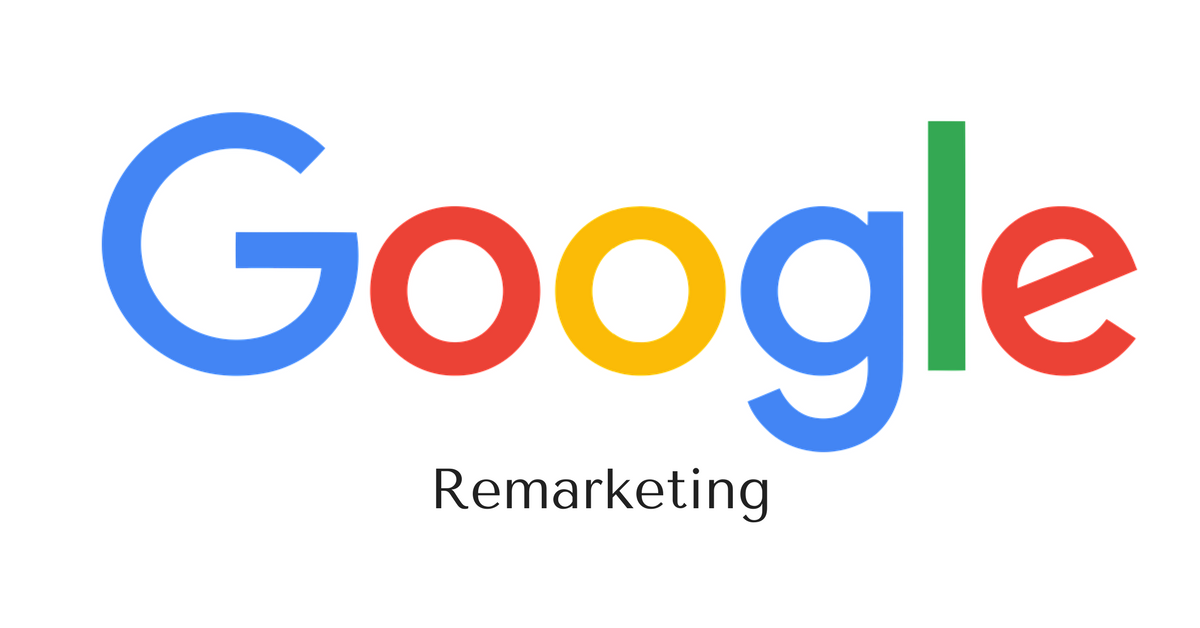



Leave A Reply